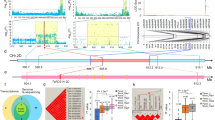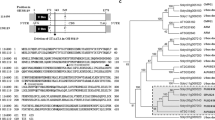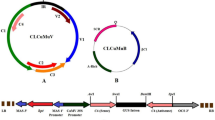Abstract
The tomato yellow leaf curl virus(TYLCV) gene that encodes the capsid protein (VI) was placed under transcriptional control of the cauliflower mosaic virus 35S promoter and cloned into an Agrobacterium Ti-derived plasmid and used to transform plants from an interspecific tomato hybrid, Lycopersicon esculentum X L. pennellii (F1), sensitive to the TYLCV disease. When transgenic F1 plants, expressing the V1 gene, were inoculated with TYLCV using whiteflies fed on TYLCV-infected plants, they responded either as untransformed tomato or showed expression of delayed disease symptoms and recovery from the disease with increasingly more resistance upon repeated inoculation. Transformed plants that were as sensitive to inoculation as untransformed controls expressed the V1 gene at the RNA level only. All the transformed plants that recovered from disease expressed the TYLCV capsid protein.
This is a preview of subscription content, access via your institution
Access options
Subscribe to this journal
Receive 12 print issues and online access
$209.00 per year
only $17.42 per issue
Buy this article
- Purchase on Springer Link
- Instant access to full article PDF
Prices may be subject to local taxes which are calculated during checkout
Similar content being viewed by others
References
Cohen, S. and Harpaz, I. 1964. Periodic, rather than continual acquisition of a new tomato virus by its vector, the tobacco whitefly (Bemisia tabaci Gennadius). Entomol. Exp. Appl. 7: 155–166.
Czosnek, H., Navot, N. and Laterrot, H. 1990. Geographical distribution of tomato yellow leaf curl virus. A first survey using a specific DNA probe. Phytopathol. Medit. 29: 1–6.
Cohen, S. and Nitzany, F.E. 1966. Transmission and host range of the tomato yellow leaf curl virus. Phytopathology 56: 1127–1131.
Czosnek, H., Ber, R., Antignus, Y., Cohen, S., Navot, N. and Zamir, D. 1988 Isolation of the tomato yellow leaf curl virus — a geminivirus. Phytopathology 78: 508–512.
Navot, N., Pichersky, E., Zeidan, M., Zamir, D. and Czosnek, H. 1991. Tomato yellow leaf curl virus: a whitefly transmitted geminivirus with a single genomic component. Virology 185: 151–161.
Keyr-Pour, A., Bendahmane, M., Credi, S., Accoto, J.P., Matzeit, V. and Gronenborn, B. 1991. Tomato yellow leaf curl virus from Sardinia is a whitefly-transmitted monopartite geminivirus. Nucl. Acids Res. 19: 6763–6769.
Davies, J.W. and Stanley, J. 1989. Geminivirus genes and vectors. Trends Genet. 5: 77–81.
Zakay, Y., Navot, N., Zeidan, M., Kedar, N., Rabinowitch, H.D., Czosnek, H. and Zamir, D. 1990. Screening of Lycopersicon accessions for resistance to tomato yellow leaf curl virus: presence of viral DNA and symptom development. Plant Dis. 75: 279–281.
Pilowsky, M. and Cohen, S. 1990. Tolerance to tomato yellow leaf curl virus derived from Lycopersicon peruvianum . Plant Dis. 74: 248–250.
Day, A.G., Bejerano, E.R., Buck, K.W., Burrell, M. and Lichtenstein, C.P. 1991. Expression of antisense viral gene in transgenic tobacco confers resistance to the DNA virus tomato golden mosaic virus. Proc. Natl. Acad. Sci. USA 88: 6721–6725.
Stanley, J., Frischmuth, T. and Ellwood, S. 1990. Defective viral DNA ameliorates symptoms of geminivirus infection in transgenic plants. Proc. Natl. Acad. Sci. USA 87: 6291–6295.
Beachy, R.N., Loesch-Fries, S. and Turner, N.E. 1990. Coat protein-mediated resistance against virus infection. Annu. Rev. Phytopathol. 28: 451–474.
Gadani, F., Mansky, L.M., Medici, R., Miller, W.A. and Hill, J.H. 1990. Genetic engineering of plants for virus resistance. Arch. Virol. 115: 1–21.
Hull, R. and Davies, J.W. 1992. Approaches to nonconventional control of plant virus diseases. Critical Rev. Plant Sci. 11: 17–33.
Mayo, M.A. 1992. Organization of viral genomes: the potential of virus genes in the production of transgenic virus-resistant plants, p. 251–263. In: Biotechnology and Crop Improvement in Asia. Moss, J. P. (Ed.). International Crop Research Institute for the Semi-Arid Tropics, Patancheru, India.
Farinelli, L. and Malnoe, P. 1993. Coat protein gene-mediated resistance to potato virus Y in tobacco: Examination of the resistance mechanisms — Is the transgenic coat protein required for protection? Mol. Plant-Microbe Interact. 6: 284–292.
Powell, P.A., Sanders, P.R., Turner, N., Fraley, R.T. and Beacy, R.N. 1990. Protection against tobacco mosaic virus infection in transgenic plants requires accumulation of coat protein rather than coat protein RNA sequences. Virology 175: 124–130.
De Kouchkovsky, F., Jupin, I., Warting, L., Bendahmane, M., Kheyr-Pour, A., Jouanneau, F., Accotto, G.P., Matzeit, V. and Gronenborn, B. 1993. Molecular biology of tomato yellow leaf curl virus (TYLCV) and potential ways to control the disease, p. 227–238. In: Molecular Biology of Tomato. Yoder, J. I. (Ed.). Technomic Publishing, Lancaster.
Hoekema, A., Hirsch, P.R., Hooykass, P.J.J. and Schilperoort, R.A. A. 1983. A binary plant vector strategy based on separation of the Vir-and T-region of Agrobacterium tumefaciens Ti plasmid. Nature 303: 179–180.
Holsters, M., de Waele, D., Depicker, A., Messens, E., Van Montagu, M. and Schell, J. 1978. Transfection and transformation of Agrobacterium tumefaciens . Mol. Gen. Genet. 163: 181–187.
McCormick, S., Niedermeyer, J., Fry, J., Barnason, A., Horsch, R. and Fraley, R. 1986. Leaf disc transformation of cultivated tomato (L. esculentum) using Agrobacterium tumefaciens . Plant Cell Rep. 5: 81–84.
Doyle, J.J. and Doyle, J.L. 1990. Isolation of plant DNA from fresh tissue. Focus 12: 13–15.
Beck, E., Ludwig, G., Auerswald, E.A., Reiss, B. and Schaller, H. 1982. Nucleotide sequence and exact localization of the neomycin phosphotransferase gene from transposon Tn5. Gene 19: 327–336.
Saiki, R.K., Gelfand, D.H., Stoffel, S., Scharff, S.J., Higuchi, R.G., Horn, G.T., Mullis, K.B. and Erlich, H.A. 1988. Primer-directed enzymatic amplification of DNA with thermostable DNA polymerase. Science 239: 487–491.
Navot, N., Zeidan, M., Pichersky, E., Zamir, D. and Czosnek, H. 1993. Use of the polymerase chain reaction to amplify tomato yellow leaf curl virus DNA from infected plants and viruliferous whiteflies. Phytopathology 82: 1199–1202.
Sambrook, J., Fritsch, E.F. and Maniatis, T. 1989. Molecular Cloning; A Laboratory Manual. Cold Spring Harbor Laboratory, Cold Spring Harbor, NY.
Feinberg, A.P. and Vogelstein, B. 1984. A technique for radiolabeling DNA restriction endonuciease fragments to high specific activity. Anal. Biochem. 137: 266–269.
Prescott, A. and Martin, C. 1987. A rapid method for the quantitative assessment of level specific mRNAs in plants. Plant Mol. Biol. Rep. 4: 219–224.
Zeidan, M. and Czosnek, H. 1991. Acquisition of tomato yellow leaf curl virus by the whitefly Bemisia tabaci . J. Gen. Virol. 72: 2607–2614.
Czosnek, H., Ber, R., Navot, N., Zamir, D., Antignus, Y. and Cohen, S. 1988. Detection of tomato yellow leaf curl virus in lysates of plants and insects by hybridization with a viral DNA probe. Plant Dis. 72: 949–951.
Navot, N., Ber, R. and Czosnek, H. 1989. Rapid detection of tomato yellow leaf curl virus in squashes of plants and insect vectors. Phytopathology 79: 562–568.
Laemmli, U.K. 1970. Cleavage of structural proteins during assembly of the head of bacteriophage T4. Nature 227: 680–685.
Joisson, C., Dubs, M.C., Briand, J. and van Regenmortel, M. 1992 Detection of potyviruses with antisera to synthetic peptides. Res. Virol. 143: 167–178.
Author information
Authors and Affiliations
Rights and permissions
About this article
Cite this article
Kunik, T., Salomon, R., Zamir, D. et al. Transgenic Tomato Plants Expressing the Tomato Yellow Leaf Curl Virus Capsid Protein are Resistant to the Virus. Nat Biotechnol 12, 500–504 (1994). https://doi.org/10.1038/nbt0594-500
Received:
Accepted:
Issue Date:
DOI: https://doi.org/10.1038/nbt0594-500
This article is cited by
-
Coat protein–mediated resistance to cucumber mosaic virus subgroup IB in black pepper (Piper nigrum L.)
In Vitro Cellular & Developmental Biology - Plant (2022)
-
Plant responses to geminivirus infection: guardians of the plant immunity
Virology Journal (2021)
-
Interaction between βC1 of satellite and coat protein of Chili leaf curl virus plays a crucial role in suppression of host RNA silencing
Applied Microbiology and Biotechnology (2021)
-
Expression of short hairpin RNA (shRNA) targeting AC2 gene of Mungbean yellow mosaic India virus (MYMIV) reduces the viral titre in soybean
3 Biotech (2019)



